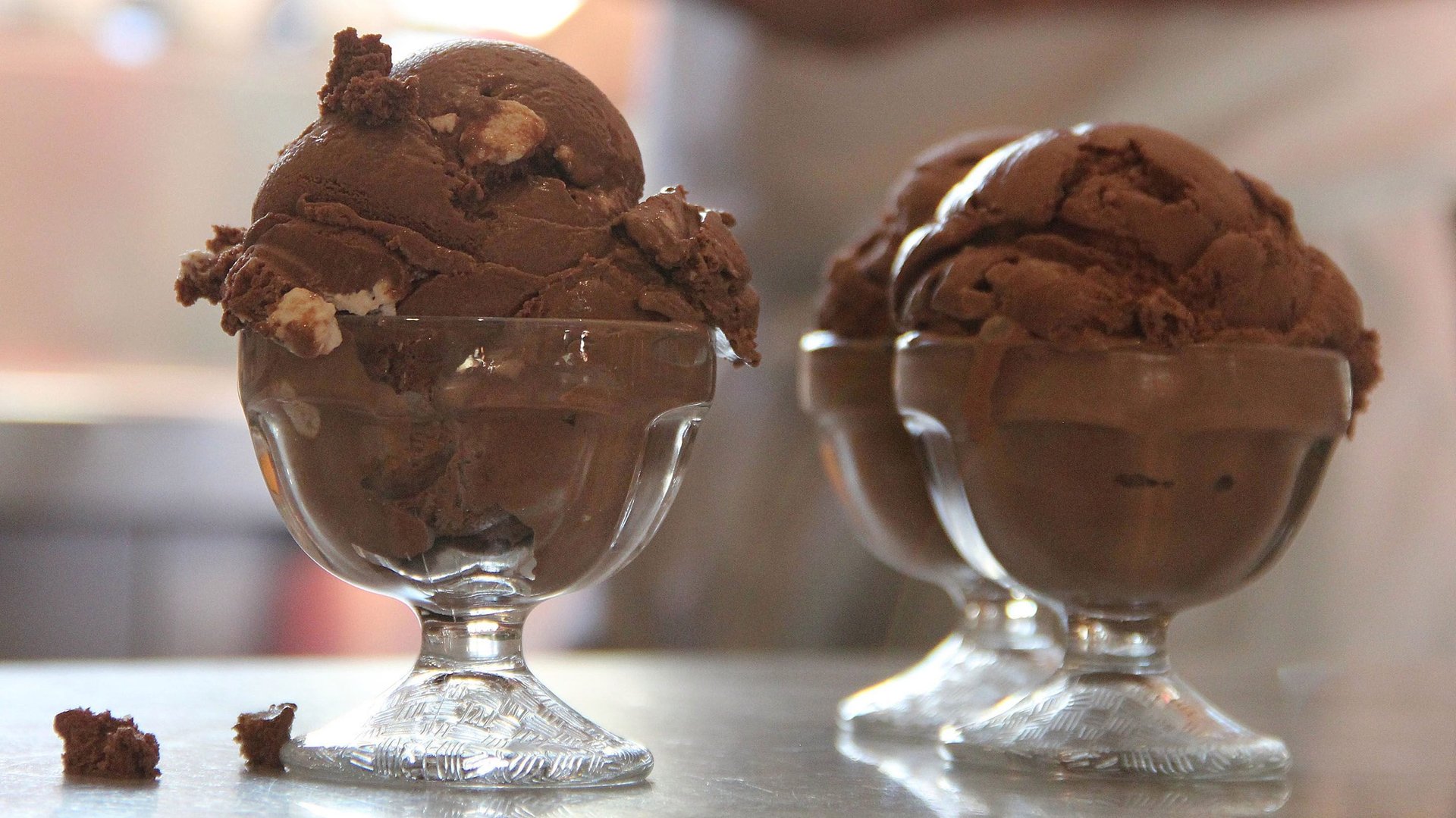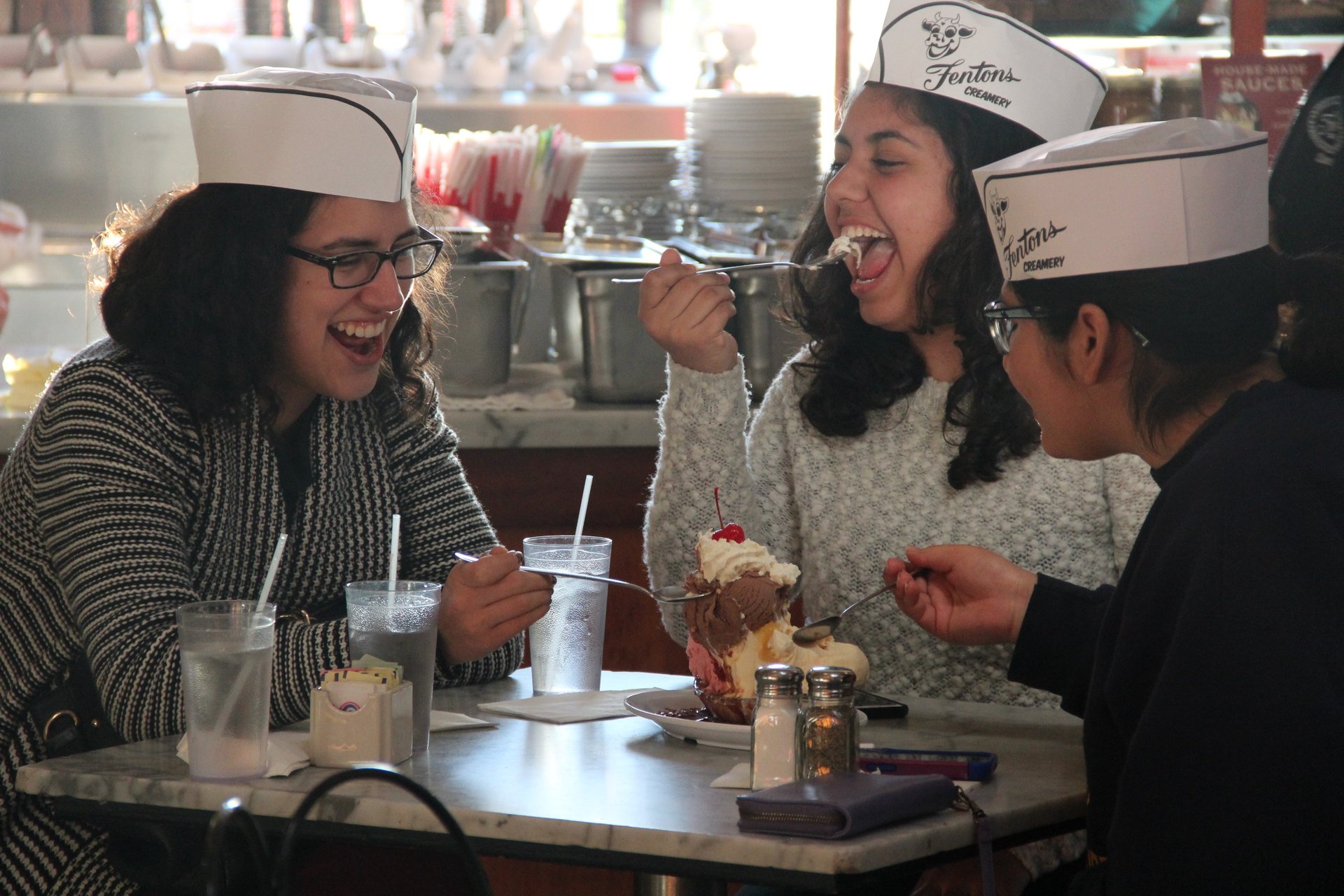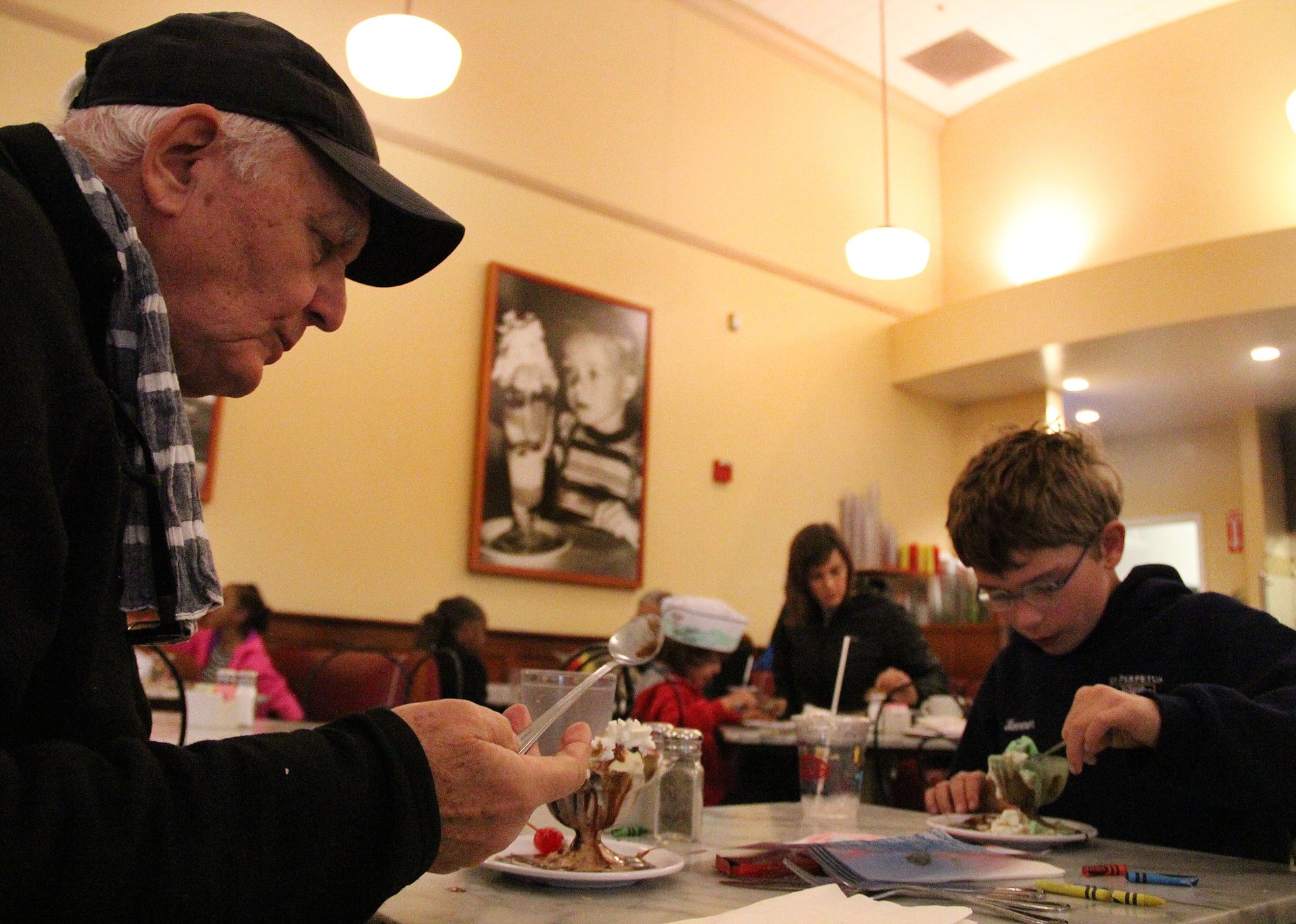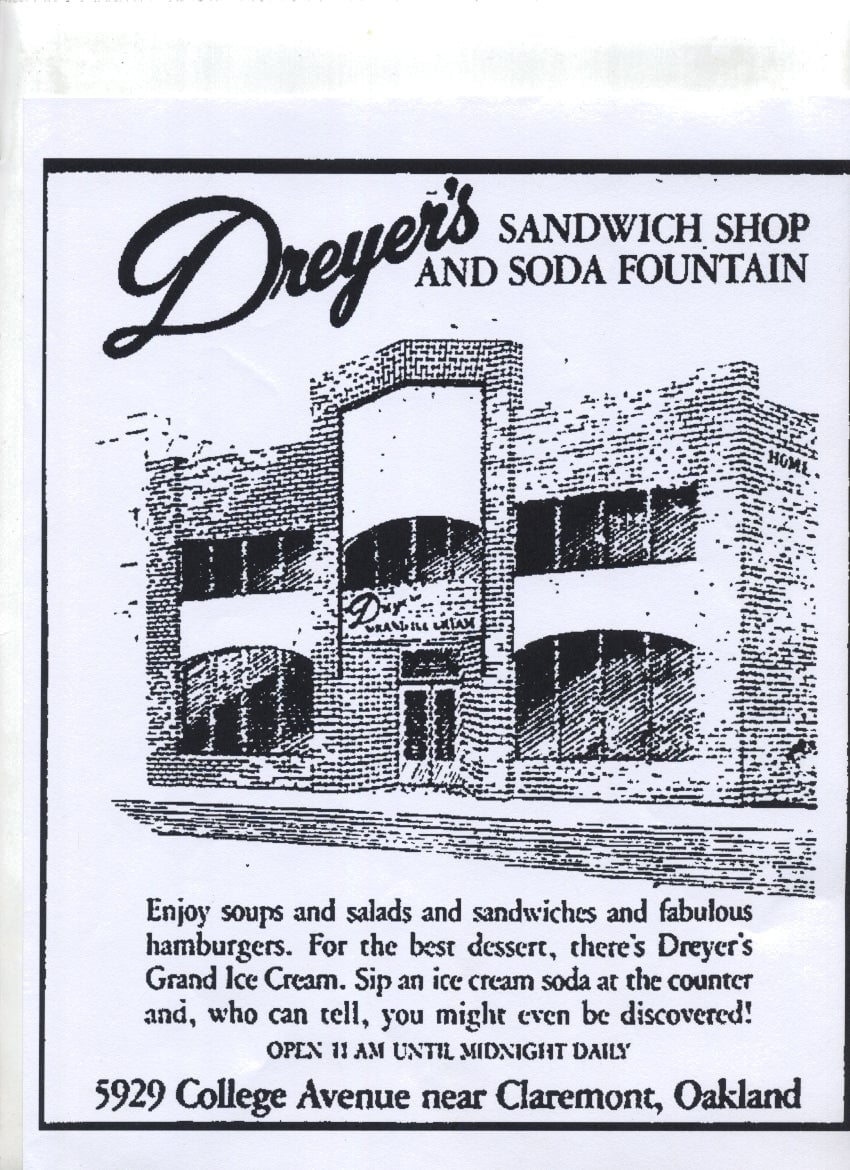Who invented rocky road ice cream? It’s complicated
Even to a skeptic, Fentons Creamery at dusk radiates charm, the light from its windows stretching into the evening like fingers. The Oakland, California institution flaunts its 120 years, with just-so red vinyl booths, a vintage-style soda fountain, and a rotating refrigerator showcasing sundaes slung with caramel and strawberry syrup.


Even to a skeptic, Fentons Creamery at dusk radiates charm, the light from its windows stretching into the evening like fingers. The Oakland, California institution flaunts its 120 years, with just-so red vinyl booths, a vintage-style soda fountain, and a rotating refrigerator showcasing sundaes slung with caramel and strawberry syrup.
At one table, a pale 30-something man eats a sundae alone, spoon in one hand and book in the other. Nearby, a group of teenagers huddle over shared bowls of ice cream, and a few tables down a woman in red lipstick and barrel braids helps a toddler gum a plate of chicken tenders. Maybe it’s the twilight talking, but watching evening bloom here, it’s easy to believe Fentons’ version of the story.
According to company lore, Melvin Fenton, grandson of Fentons founder Elbridge Seth (E.S.) Fenton, was the first person to invent rocky road ice cream. A more detailed version, outlined in old Fentons marketing materials (and referenced in simplified form on the current Fentons menu), tells it like this:
“George Farren, candymaker at Fentons Creamery, was making a Rocky Road candy bar at Fentons and decided to blend it into an ice cream flavor. At the time, he was good friends with William Dreyer and Joseph Edy, who had an ice cream shop on Grand Avenue in Oakland. As the story goes, Dreyer soon began making Farren’s recipe for Rocky Road to serve his customers, using almonds instead of the English walnuts.”
That Grand Avenue ice cream shop would go on to become Dreyer’s Ice Cream, also known as Edy’s in eastern states. And hidden in these two sentences is the nut, so to speak, in rocky road’s origin story—Dreyer’s claims to have invented the flavor, too. “People were bummed [in 1929],” the company says on its website. “Dreyer’s wanted to help. So we created a flavor with a name everybody could relate to: rocky road.”
A blend of chocolate ice cream, nuts, and marshmallows, rocky road was among the first ice cream flavors to include “mix-in” materials, a symbol of the modern indulgence made possible by refrigeration technology. Over the years, various companies would try to add their own twists—rocky road with pecan, strawberry rocky road, pineapple rocky road—but the original version remains among the most popular ice cream flavors. Today, Fentons is still a flourishing local business, while Dreyer’s is part of multinational conglomerate Nestle. It might seem on the surface like a classic underdog tale. But the story of rocky road, and the evolution of the two companies that claim it, is just a bit stickier.
The rocky road to rocky road
Fentons wears its history on its walls, in a series of black-and-white photos that span more than a century. In one shot, E.S. Fenton sits with his brother in the horse-drawn wagon they used to deliver cream at the original Fentons Creamery location, not long after its 1894 founding. In another, an old-fashioned truck idles by one of Fentons’ barns at the start of the area’s dairy renaissance. Next to that, the Fentons entranceway sports what was rumored to be Oakland’s first neon sign.
Dreyer’s story began around the same time as Fentons’. As founder William Dreier liked to tell it, the year was 1906; he was 18 years old, working on a steamer traveling to New York from his native Germany. One day, Dreier was asked to make a frozen dessert for the boat’s captain. He served up water ice—similar to ice cream and a trendy dish at the time—and received such positive feedback that he decided to make ice cream his life’s work. Dreyer (née Dreier) eventually settled in California, where he worked for a series of ice cream shops before meeting candymaker Joseph Edy in 1926. The first of Edy’s six Character Candies Shops had debuted a year earlier, and the two soon became partners. They opened Edy’s Grand Ice Cream in Oakland’s Grand Lake neighborhood, a fashionable district crowned by an extravagant vaudeville theater—about a mile from Fentons.
Both Fentons and Dreyer’s are indisputable ice cream innovators. Perennial flavor favorite Cookies ‘n Cream was developed in the 1980s by Dreyer’s taster John Harrison, whose taste buds were famously insured for a million dollars. Fentons’ current owner, Scott Whidden, cooked up Cream Caramel Almond Crunch as a 75th birthday present to neighboring California College of the Arts, with which the flavor shares its initials. Over the decades, both companies have pioneered a raft of new confections, most of whose genesis has gone uncontested. Among them, rocky road is the exception.

The flavor takes its name from a popular candy whose origins are similarly hazy. In the early 1900s, when E.S. Fenton was just beginning to provide milk and cream for much of Oakland, a rocky road candy bar featuring nuts and marshmallow was gaining popularity. Bay Area-based Annabelle Candy first made its fortune selling a version of the confection out of a Mission Street candy shop, and other stores hurried to follow suit. Advertisements of the day highlight the candy’s pervasiveness. Take HC Capwell Company, one of Oakland’s Grand Dame department stores, which ran an ad in a 1918 issue of the Oakland Tribune—(next to one for equally trendy “Milanese shorty bloomers” ($3.45)—that hawked “a marshmallow, chocolate, and walnut confection freshly made for Saturday. Special, 59c lb.”
At the time, most ice cream came only in Neapolitan flavors—chocolate, vanilla, and strawberry—which made the birth of rocky road all the more remarkable. It was also arguably the first time someone thought to combine candy and ice cream. John Thomason, who joined Dreyer’s in 1970 and worked in several high-level positions, including as vice president of manufacturing, says that “someone” was William Dreyer.
The story Thomason learned when he worked at the company was as follows: On the eve of the stock market crash in 1929, William Dreyer—struck by some creative dairy spark—got the materials together to mix chocolate ice cream with nuts and marshmallows, but immediately encountered a problem. The marshmallows were too big. So that afternoon, Thomason says, Dreyer “took his wife’s pinking shears, cut the big craft marshmallows into four pieces, and put them into the chocolate ice cream.” Rocky road was born.
We all scream for ice cream
In the late 1920s, Oakland was a medium-size port city—no backwater, but not exactly an obvious home for 25 dairies, cheesemakers, and ice-creameries. One crucial innovation helped it become ground zero for the west coast dairy renaissance, the creation of rocky road, and the flourishing of both Fentons and Dreyer’s: refrigeration.
California dairy in the decades leading up to the Depression was still ruled by the milkman, who traveled from house to house in blue- and white-striped overalls, carrying a whalebone whip to discipline his horse. The invention of the in-home refrigerator in 1913 precipitated an enormous change, making it possible for homeowners to buy more dairy further in advance. In 1920, the state of California produced 87 million pounds of butter, cottage cheese, and ice cream. Over the following decade, that number rose precipitously.
Amid all this, Oakland in 1922 hosted its first Pacific Slope Dairy Shows, including milking demonstrations, cream and cheese contests, and meetings of industry groups like the oddly named Yellow Dogs, of which both Edy and Dreyer were members. Dreyer became famous at the Pacific Slope show for winning best vanilla ice cream (the industry standard) several years running.

At the same time, ice cream was becoming an epicenter for socializing, especially as Prohibition took hold, leaving ice cream parlors to fill the void left by bars. “Young couples from Oakland’s Piedmont neighborhoods caught a movie at the Grand Lake Theater, then retreated to the fire-lit and sophisticated interior of Edy’s parlors to huddle over a sundae,” wrote historian Glenn Bugos in a 1997 promotional pamphlet for Dreyer’s. “Housewives entertaining dinner guests stopped by to pick up five-layer ice-cream cakes, fancy ice-cream logs, or ice-cream molds hand-decorated for the holidays.”
Fentons was also flourishing. As the Depression hit, Oakland’s role in the dairy industry (and as one of the west coast’s major ports) kept it afloat. Even after World War I started, Americans kept eating ice cream in increasingly enormous quantities, with an almost patriotic zeal. “Ice cream,” Bugos wrote in a company history compiled around the same time, “as a relatively cheap treat, has constantly [sic] proven to be recession-proof.”
Low-tech, high-touch
After individual refrigeration came industrial refrigeration, which further transformed the industry and paved the way for new kinds of growth—and growing pains. For Dreyer’s, this change arrived in 1963, when William Dreyer sold his company to a trio of dairy industry insiders, among them Dreyer’s head of sales, Ken Cook.
Cook would become a close friend; Thomason, who worked with Dreyer directly, says Cook was “more of a son to Bill Dreyer than his own son.” Like Dreyer, Cook had a temper—Thomason remembers him once hurling an entire container of ice cream on the factory floor in anger—but he was also known for caring deeply about his business and employees. Fentons’ Whidden says Cook “knew his plant, he knew all his staff members, he knew his accounts. He knew where the cows were, he knew his suppliers. This is not a man stuck in the office.”
Whidden describes Cook as “a showman, a natural salesman, but an authentic one—not sleazy.” Employees and friends remember Cook’s gregariousness and penchant for Italian suits and alligator shoes, as well as his love of Dreyer’s rocky road story. Cook’s daughter, Cindy Cook-Boettner, says her father named his backyard miniature-golf course after the flavor, and he and his wife drove a Cadillac whose vanity plate read “RCYRD.”
Whidden, who grew up in Oakland, remembers seeing the brown and white Dreyer’s trucks while commuting to his job as an apprentice at nearby Bott’s Ice Cream, which he would later come to own. Fascinated by the scale of Dreyer’s operation, Whidden called the company’s office, and Cook invited him to lunch. Thus began an industry friendship that would last until Cook’s death in 1991. “[Cook] was more than willing to share,” says Thomason. “He was even overly generous.”
Small businesses were a priority for Cook, who served as president of the local Chamber of Commerce and preferred to shop at mom-and-pop grocery stores. Following in the footsteps of his predecessor, Cook steered Dreyer’s into supermarkets up and down the west coast using what Whidden describes as a “low-tech, high-touch” approach, involving personally securing accounts with everyone from local grocers to massive supermarket chains. Cook went out of his way to give contracts to small-scale establishments and to find ways to support them. The strategy worked: Under Cook, Dreyer’s went from producing half a million gallons of ice cream in 1969 to 1 million in 1973 and 3 million in 1977.
As he sought to expand Dreyer’s even further, Cook was denied a bank loan. In 1977, restaurateurs Gary Rogers and Rick Cronk made an offer to buy the company, and Cook accepted. But tensions mounted as it became clear that the duo didn’t share Cook’s business philosophy. Cook had expected to play a bigger part in the buyout proceedings and became increasingly angry as he was forced to cede control.
“His primary concern was relationships that he had specifically built, relationships he felt were personal,” says Whidden. “He was a guy that got a family in Sacramento to create a warehouse and become a distributor for Dreyer’s ice cream. That distributorship was later cancelled and became a part of corporate Dreyer’s.”
Cook-Boettner, who was in her 20s at the time, says her father was “upset and mad and hurt at the same time.” She remembers him saying to her, “What they promised me isn’t happening.”
“You need to buy Fentons”
It was against this backdrop that, in 1987, Whidden says Cook came to him with a rather remarkable piece of advice: “You need to buy Fentons.”
In the 1950s, Bill Morison, husband of E.S. Fenton’s granddaughter Virginia, convinced the Fenton family to sell the company to Golden State Dairy, where Morison worked. Golden State was later absorbed by Foremost, a dairy company founded by JC Penney that itself merged with medical conglomerate McKesson in the 1960s. The familial connection made Fentons a strange feather in Foremost-McKesson’s cap; Whidden says it enjoyed a place of privilege within the company, protected from the vagaries of the market, but also failed to grow or evolve. Cook didn’t want that for any ice-cream maker.
“Rescue it,” Whidden remembers Cook telling him. “[Foremost doesn’t] know what they have.” Whidden says Cook meant that Fentons would never get the attention it deserved in such a huge, diversified company—and that Foremost didn’t realize it had acquired the birthplace of rocky road.
This moment, Cook’s “confession” to Whidden, is a crucial anecdote in Fentons’ version of the rocky road genesis. Whidden says Cook “was trying to get me to take Fentons seriously. He said, ‘No, this place has a legacy.’” Then, Whidden says, Cook admitted to taking the rocky road glory for Dreyer’s, since no one else was making use of it. “I want you to know that it was Fentons that invented rocky road,” Whidden says Cook told him. “And I capitalized on it in our marketing because Fentons was not capitalizing. Under Foremost, they didn’t care.”
Whidden sees all this as a change of heart: If Cook could help a small business, even if it meant creating competition for the company he worked so hard to build, “then he was going to do that.”
Cook-Boettner says she never heard her father talk about an episode like this or tell a rocky road origin story that didn’t start with William Dreyer. But “I can say that might have happened,” she says, “that he wanted someone to carry on thinking of the small businesses.”
Thomason, on the other hand, calls this portion of Whidden’s story “full of shit. I knew Ken Cook as well as anyone in his career,” he says. “He had too much respect for Bill Dreyer [to do something like that].”
Ice-cream innovation
In another industry, this might have been where the lawsuits started—a different kind of cold war. But in the case of rocky road, the usual legal protections don’t easily apply.
To qualify for a patent, for example, an invention must be novel and not obvious, two terms that are defined by statute and have been disputed in hundreds of cases over the years. It would be difficult to argue that putting an existing confection into an existing ice cream constitutes a novel idea. (In fact, the idea for rocky road ice cream may well have been arrived at simultaneously in Kansas, where the 1920 edition of Rigby’s Reliable Candy Teacher called for a rocky road recipe involving “chocolate ice cream, honey creme whip, almonds, pecans, and walnuts.”) Nor does it take much sleuthing to dig into a bowl and think, “There’s chocolate, there’s marshmallows. Oh, and is that a nut?”
Patents are also temporary, explains patent lawyer Ben Hanrahan, and the type of patent for which a recipe might qualify lasts only 20 years and is nonrenewable. Worse, a patented item “necessarily becomes part of the public domain,” Hanrahan says. “Then you have a limited time where you have ownership of the patent, at which point the patent expires and everyone can make and use it.”
Another tool sometimes used in junk-food wars is the trade secret and its occasional partner, the non-disclosure agreement (NDA). Generally speaking, trade secrets are pieces of information that a company keeps secret and in doing so imbues with some commercial value. Perhaps the most famous example is Coca-Cola, which as urban legend has it divides its famous soda formula in two and only allows employees to see one half at a time. Trade secrets do have a catch, though: They rest on the idea that no one can figure out the formula for themselves. Again, that’s not so hard to do for rocky road.
The last option, trademarking—which keeps commercial entities from using a name, logo, or packaging associated with another business—wasn’t as common in William Dreyer and E.S. Fenton’s time as it is today. Federal registration (which is not essential to protect a mark or make a trademark claim, but does strengthen it) would have involved a complicated application. And while securing a trademark today is somewhat less complex than back then, it’s far too late now to act on rocky road. The name has long since entered general use, making it near-impossible to argue compellingly for a trademark.
So rather than debating who “owns” rocky road, perhaps a more interesting consideration is why Dreyer’s and Fentons both claim it. “The question is, how do you present the invention of rocky road?” says historian Bugos. “Fentons might like to say they invented it as a part of an old-fashioned tradition. Cronk and Rogers saw it as early evidence of innovation that remains a key part of Dreyer’s corporate culture.”
“I have proof”
“By the turn of the century, some company is going to be the Coca-Cola of the $5.3 billion packaged-ice-cream market,” Cronk is quoted as saying in Bugos’ 1997 promotional pamphlet. “Why shouldn’t that company be Dreyer’s?”
Under Cronk’s leadership, Dreyer’s chased that dream, shedding more of its “low-tech, high-touch” roots in the process. By the mid-1990s, the company had revenues of $796 million, and both GE and Nestle had bought stakes. In 2006, Nestle bought Dreyer’s outright, making it a part of Nestle USA (also known as “Noosa”), where it was lumped in with prepared food (Stouffer’s, Lean Cuisine), beverage (Nesquick), and confections. Dreyer’s now competes with ice cream brands owned by Unilever, such as Breyer’s, Magnum, and Ben & Jerry’s.
Dreyer’s is still headquartered in Oakland, in a fashionable area equivalent to Grand Lake in its heyday; neighbors include a jogging-clothes boutique and a salon “specializing in exquisite brows.” An arch painted with the peeling Dreyer’s logo welcomes visitors to what is now a much-rehabbed office building. Inside, photos of foodstuffs line the walls, and fiberglass displays highlight new products. Even the bathrooms sport technicolor advertisements for ice cream cones and popsicles.

On the building’s second floor, former brand communications manager Diane McIntyre shows me black-and-whites photos of the original Edy’s Character Candies shops, all checked parquet floors and delicate glassware. After 34 years with Dreyer’s, McIntyre is technically already retired, but has yet to pack up the memorabilia that littered her office: old photos, tchotchkes, a clock in the corner with nothing on its face except the words “It’s time for ice cream!”
McIntyre remembers Dreyer’s humbler roots, including the years she and other staffers spent answering customer complaints personally, a tradition started by Cook. When it comes to the rocky road debate, she brushes off Fentons narrative. McIntyre is “positive” about Dreyer’s version of events. Better yet, she says she has proof.
That “proof” is an unpublished manuscript called “The Birth of Rocky Road,” a Dreyer’s company history that Cook himself wrote in 1981, shortly before resigning. Dreyer’s still treats the text as gospel, and it recounts the same tale Thomason was taught during his tenure. Ask any Dreyer’s employee about rocky road, and you’ll hear some version of that story; likewise, all of their publicity materials point back to it.
McIntyre points out the manuscript’s description of that 1929 afternoon when, inspired by rocky road candy, William Dreyer “produced the Worlds [sic] first batch of Rocky Road Ice Cream.” She then digs out a slim black cube filled with old recipe cards and a worn leather folio, labeled “W Dreier.” Amid lists of ingredients for pumpkin ice cream and fountain hot fudge written in Dreyer’s elegant, looping handwriting are several typewritten recipes, including one for rocky road. No date, no signature.
On “The Birth of Rocky Road,” Whidden says he “wouldn’t expect anything else” from a book Cook wrote for Dreyer’s. “[Cook] said to me, ‘I took credit for inventing rocky road,’” Whidden says. “There’s no contradiction there at all. I already knew that.”
Big spoon, little spoon
Although multimillion-dollar Nestle may dwarf Fentons today, the latter is no sob story. Fentons sells an estimated one ton of ice cream each day. It has three locations, including one that does a brisk business at Oakland’s airport. Whidden says he has turned down opportunities for further expansion.
One crowded weekend afternoon, the sun streams through the original Fentons windows, dappling a 20-something couple sharing one of those famous fudge-slung sundaes. Nearby, an older gentleman in a golf cap and wheelchair sits with two elderly family members, chatting over bowls scraped nearly clean. A bell that rings for birthdays peals repeatedly, prompting the crowd of customers to break into song. “It was good to meet here because I want you to hear that chatter,” Whidden says to me of the din. “It’s different than buying a carton of ice cream in the store, putting it in your shopping cart, and taking it home.”
Whidden seems deeply at home at Fentons, as he should—he had a hand in curating nearly every element of the restaurant’s meticulous design, down to the curve of its old-fashioned counter. Most of these vintage elements are re-creations; Whidden says he hopes they help customers indulge in a bit of ice cream nostalgia that connects them to other sweet memories.
Dreyer’s claim on rocky road is “just about marketing and making [the company] seem smaller,” Whidden says, whereas Fentons “chose to stay small.” He sees it as an extension of the ice cream industry’s overall shift from small players to big conglomerates. “It’s kind of hard to have a relationship with Switzerland,” Whidden says, referring to Nestle’s European headquarters. He misses when competitors were more respectful, sometimes even friendly.
Of course, that camaraderie is part of why rocky road’s origins are so murky: The two companies with claims on the flavor are inextricably intertwined. The strange history of rocky road ultimately boils down to three businessmen in a small city a hundred years ago, contemporaries who were friends and shared what they had. Their companies’ trajectories are a reminder of how much US corporate culture has evolved.
Rocky road’s origin story may never be resolved, at least not definitively. But Fentons’ version will remain on their menu, Whidden says, “because that’s the lore.”
At the Oakland shop, a black-and-white print shows a young boy eating a sundae, his eyes wide with enthusiasm. The boy is the son of Fentons’ longest-serving waitress, but Whidden says dozens of people over the years have told him the shot is of their son, or a friend, or a neighbor from their childhood. He never corrects them. “Maybe they did have that shirt; maybe they do have a picture just like that,” Whidden says. “We don’t need to tell people what their reality is. That’s the fun thing about storytelling.”